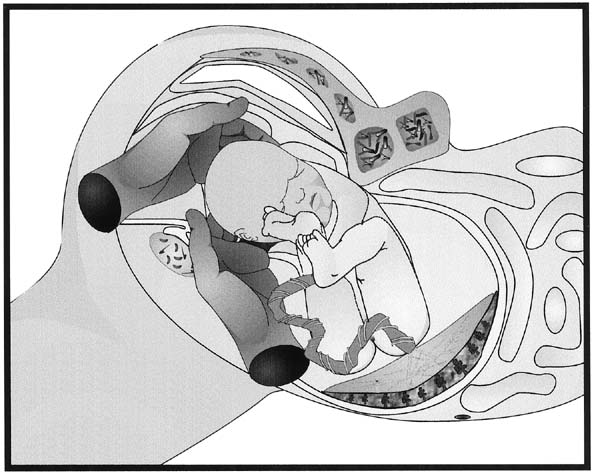Manual Removal Of Placenta At Caesarean Section
OBJECTIVE: To compare blood loss with spontaneous delivery and manual removal of the placenta during caesarean section. DESIGN: A randomised controlled trial. SETTING: Four university hospitals between September 1999 and June 2002. POPULATION: A total of 472 women delivering by caesarean section at term were randomised to spontaneous placental delivery (n= 235) or manual removal (n= 237). METHODS: The allocation was made by opening the next available of a series of sealed opaque envelopes and derived from a computer-generated list of numbers. MAIN OUTCOME MEASURES: Significant blood loss, defined as either a drop in haemoglobin of greater than 2.5 g/dL, or the need for blood transfusion. RESULTS: The mean interval between delivery of the newborn and the placenta was longer in the spontaneous delivery group (3.4 vs 1.9 minutes), but the mean duration of the operation was similar.

Significant blood loss occurred in 30 women (13%) in the spontaneous delivery group and 49 women (21%) in the manual removal one (RR 0.62; 95% CI 0.41-0.94). Glock Serial Number Database here. Post-operative fever affected 6 and 5 cases, respectively, and antibiotics were used in 14 and 12 cases, respectively. CONCLUSIONS: Allowing spontaneous delivery of the placenta reduces significant blood loss without increasing operating time.
Purpose: Cesarean section (CS) rates have increased; this is especially concerning in developing countries. The mode of placental delivery contributes to morbidity associated with CS and determines blood loss during CS. We aimed to compare manual removal versus spontaneous delivery of the placenta at CS. Methods: In a randomized controlled trial, 574 women admitted for primary or repeat elective CS were randomized into two groups.
Placental delivery with cord traction is more effective than manual removal at caesarean section. Clinical question: Which is the most effective method of delivering the placenta at caesarean section? Bottom line: Delivery of the placenta with cord traction has advantages compared to manual removal.These include less.
In group A, the placenta was manually removed, whereas in group B, the placenta was left for spontaneous delivery. Blood loss, operative and postoperative data were recorded. Results: Blood loss was 875.2 ± 524.2 ml in group A versus 731. Microsoft Office 2010 X64 German Language Pack Final Grade on this page. 8 ± 426.7 ml in group B ( p =.001), with a significant drop in postoperative HB ( p =.015) and HCT ( p =.031).
Free Download Material Library 3ds Max 9 Trial Download here. In group A, odds ratios for blood loss (>1000 ml), HB drop (>4g/dl), postpartum hemorrhage and blood transfusion were 2.581, 2.850, 2.614 and 1.665, respectively. However, the total operative time ( p =.326), duration of hospital stay ( p =.916) and intensive care unit (ICU) admission ( p =.453) were not statistically different between the two groups.
Conclusions: Manual removal of the placenta at CS is associated with a higher risk of blood loss, postpartum hemorrhage and blood transfusion, with no decrease in operative time.